The judge's recruitment in the brazilian judiciary and the inclusion of the disabled person: a reflection in the light of the theory of justice
DOI:
https://doi.org/10.17808/des.52.613Keywords:
judges recruitment, judiciary, reservation of vacancies, candidates with disabilities, theory of justiceAbstract
This paper aims to study the affirmative actions of reservation of vacancies in judge's recruitment from the theory of justice, analyzing their compliance with the principle of equal opportunities that should characterize the contemporary democratic societies. Examination of the theoretical framework offered by John Rawls, Ronald Dworkin and Amartya Sen concluded that the rules of the National Council of Justice to deal with the reservation of vacancies for the disabled people are in line with the principles of correction of material justice, for ensuring fair opportunity to this social group due to his inability to develop on equal, in the context of the, reasonable life projects. The investigation also concluded that despite the settlement of those affirmative actions, some issues are still open, such as institutional parameters relating to career development, even for being such recent reverse discrimination policies in the judiciary's composition.
References
BITTAR, Eduardo C. B.; ALMEIDA, Guilherme Assis de. Curso de filosofia do Direito. São Paulo: Atlas, 2015.
CHAVES, Daniela Lustoza Marques de Souza. Mercado de trabalho e discriminação etária: a vulnerabilidade dos trabalhadores 'envelhescentes'. São Paulo: LTr, 2006.
DALLARI, Dalmo. O poder dos juízes. São Paulo: Saraiva, 1996.
DWORKIN, Ronald. A virtude soberana: a teoria e a prática da igualdade. São Paulo: Martins Fontes, 2005a.
__________. Uma questão de princípio. São Paulo: Martins Fontes, 2005b.
__________. Justice for hedgehogs. Harvard Press: Cambridge/London, 2011.
FERRAZ, Octávio Luiz Motta. Justiça distributiva para formigas e cigarras. Novos estudos - CEBRAP [online], São Paulo, n.77, pp. 243-253, 2007.
GARAPON, Antoine. Bem julgar: ensaio sobre o ritual judiciário. Lisboa: Piaget, 1999.
HESSE, Konrad. A força normativa da Constituição. Porto Alegre: Fabris, 1991.
LEITE, Carina Lellis Nicoll Simões. As audiências públicas no STF: mero instrumento de legitimação formal? In: SARMENTO, Daniel (coord.). Jurisdição constitucional e política. Rio de Janeiro: Forense, 2015.
POMPEU, Gina Vidal Marcílio; SIQUEIRA, Natércia Sampaio. Realização da justiça, oportunidade e capacidade: da igualdade formal à igualdade material no que concerne ao acesso à educação superior dos negros por meio do sistema de cotas nas universidades. In: ALEXY, Robert; BAEZ, Narciso Leandro Xavier; SANDKÜHLER, Hans Jörg; HAHN, Paulo (orgs.). Níveis de efetivação dos direitos fundamentais civis e sociais: um diálogo Brasil e Alemanha. Joaçaba: Editora Unoesc, 2013.
RAWLS, John. Justiça e democracia. São Paulo: Martins Fontes, 2002.
__________. El liberalismo político. Tradução: Antoni Domènech. Barcelona: Crítica, 1996.
SILVA, Marcel Régis Valente da. Cotas raciais em concurso público: análise de sua constitucinonalidade. Disponível em: http://www.repositorio.uniceub.br. Acesso em 06.12.2015.
SEN, Amartya. A ideia de justiça. São Paulo: Companhia das Letras, 2011.
WALZER, Michel. Esferas da justiça: uma defesa do pluralismo e da igualdade. São Paulo Martins Fontes, 2003.
ZAFFARONI, Eugenio Raúl. Poder Judiciário. São Paulo: Revista dos Tribunais, 1995.
Downloads
Published
How to Cite
Issue
Section
License
The submission of articles for publication in the Law, State, and Society Journal(Revista Direito, Estado e Sociedade) implies the agreement of the authors with the following terms:
1. The author(s) authorize the publication of the text in an issue of the journal;
2. The author(s) assure that the submitted text is original and unpublished and that it is not under evaluation process in other journals;
3. The author(s) assume full responsibility for the opinions, ideas, and concepts sustained in the texts;
4. The author(s) grant the editors the right to make textual adjustments and adjustments to the journal's publication standards;
5. Total or partial reproduction of the articles is allowed, as long as the source is explicitly cited.












